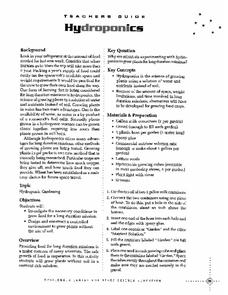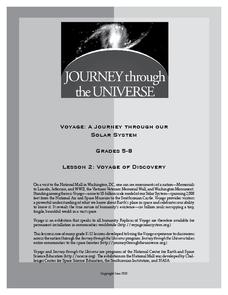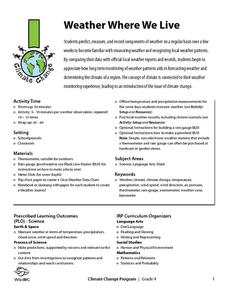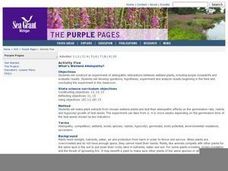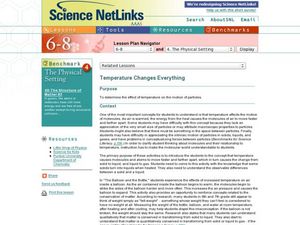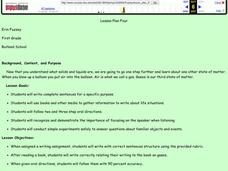Curated OER
Hydroponics
Students experiment with growing food using hyrdroponics. In this science lesson, students grow lettuce in a confined space with weight limitations. Students start a plastic pop bottle garden observing the growth and charting it....
Journey Through the Universe
The Voyage Scale Model Solar System
Young scientists learn how to select a scale factor for a large scale model. Then they figure the scale for each of the planets and the distance between them. Finally, they construct a giant scale model of the solar system and answer...
Journey Through the Universe
Voyage of Discovery
Did you know that Pluto is smaller than the United States of America? It is difficult to conceptualize the size of planets and the distance between them, and the lesson addresses those exact issues. After a discussion, pupils create...
Curated OER
Nutrition in Space
Students compare and contrast the process of dehydration with the processes of freezing and canning. They predict energy sources that may be accessible in the future in different environments such as the moon and planets, most notably Mars.
Curated OER
Soybeans in Space
Students work together to design an experiment that compares and contrasts differnet plant cultivation systems. In groups, they evaluate the results of the experiment to discover if the cultivation system could be used in space. They...
Curated OER
Toys in Space
Studentsexplore how gravity affects the operation of toys and simple machines. They watch a video and experiment with simple machines.
Curated OER
Astronauts Train in Deep-Space Brine
Students examine an article on astronauts training in deep space brine then discuss what they learned. In this investigative lesson students get into groups and design an exercise that includes isolation, silence and conflict...
Curated OER
Space Science: Journey Through the Solar System
Learners explore the Solar System and examine the characteristics of al the planets. Through research and discussion, they create catalogs of the Solar System's components. Next, students use their findings to create Powerpoint...
Curated OER
Plant Growth - Light and Shade
Third graders conduct an experiment comparing plants. In this plant lesson, 3rd graders plant seeds and grow two varieties of plant comparing the light needed for it to grow. Students make predictions and record their...
Curated OER
Science in the Garden
Young scholars examine soil from their local environment. In this garden activity, students recognize the importance of soil in the garden. Young scholars explore the contents of the local soil.
Curated OER
Water and Ice
Young scholars participate in various air experiments to understand that air is all around us. In this states of matter lesson, students focus on the role of air in the water cycle. Young scholars understand that air is densest near the...
Wild BC
Weather Where We Live
Over a span of two weeks or more, mini meteorologists record weather-related measurements. What makes this particular resource different from others covering similar activities are the thorough details for the teacher and printables for...
DiscoverE
Shaky Ground
You're on solid ground if you decide to use the resource. A simple activity has young engineers investigate the problem of liquefaction. A battery placed on dry sand will stay standing—but not if scholars add water to the cup.
Bantam Books
The Tempest: Chalk Talk
Discussion doesn't always need to be spoken. Before you begin The Tempest by William Shakespeare, have kids connect their ideas and experiences to central questions of the play with a silent discussion activity. Once they have...
Curated OER
What's Wetland Allelopathy?
Students study plants and what they need to thrive and survive. They make plant extracts from chosen wetland plants and test their allelopathic effects on the germination rate, radicle growth, and hypocotyl growth of test seeds of other...
Curated OER
Cooler In The Shadows
Students investigate the concepts of shadows and how they are projected with objects different positions in relation to the sun. They conduct an experiment by observing objects in different positions. Then students record the observations.
Curated OER
I Wonder What Would Happen if Lots of Manduca Lived in a Small Place...
Students discuss the reasons why humans fight and look for similiarties in animals. They make predictions on what they think will happen when they observe insect crowding. They make conclusions about their predictions to end the activity.
Curated OER
Water and Ice
Students investigate how water goes from a solid to a liquid then back again. In this experimental lesson students conduct their own experiment and see how water changes form.
Curated OER
Plaster Sculpture – subtractive method
Practice the subtractive sculpture process with your class. They'll discuss the subtractive method, art form and space, then design a sculpture which they will create from a block of plaster. Technical instructions are included.
Curated OER
Sensing Energy: Designing to Stay Cool
Students examine the energy the sun produces on a daily basis. In groups, they discover the properties of visible and invisible light. They also adjust the exposure time to change the properties of various objects. To end the lesson,...
Curated OER
Radiation Budget Lesson: Exploring Albedo
Students experiment with sunlight and temperature. They study the definition of albedo, or the percentage of incoming sunlight that is reflected, rather than absorbed.
Curated OER
Temperature Changes Everything
Middle school chemists visit interactive websites in order to discover what happens to molecular motion when heat is added to matter. They conduct an experiment that demonstrates the expansion of matter with the addition of heat. A lab...
Curated OER
Marine Habitats of Galveston Island
Four lessons introduce elementary ecologists to salt marsh and sandy beach habitats. In the first lesson, they place shells and other materials in vinegar to determine if they contain calcium carbonate. In the second lesson, they read a...
Curated OER
Matter
First graders are read a story about the various stages of matter with a focus on gases. Using a ziploc bag, they capture as much air as possible and discuss how it takes up space even though it is invisible. To end the lesson, they blow...
